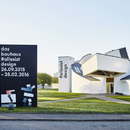Biography
A key figure in rationalist architecture, Walter Gropius (1883-1969) is numbered among the fathers of modern architecture for the historical and social impact of his projects built in Europe and the United States over more than 50 years. The upper class family in which he grew up brought him into contact with the world of architecture early in life, and he studied in Munich and Berlin and above all trained in the studio of Peter Behrens (1908-1910), who was working on AEG projects at that time. This is where Gropius began “to conceive that clear, objective method of design, always aimed at privileging the building’s functional aspect” (Di Marco) and this is where he met Adolf Meyer, with whom he opened a studio in Berlin in 1910.
Their partnership produced the Fagus buildings (1911) in Alfeld, innovative industrial buildings made of iron and glass, “the first and most significant example of the Neues Bauen in Germany (...)” (Schuster) and a model factory designed for the World’s Fair in Cologne (1914), in which the classical elements of the façade coexist with the modernity of new materials and transparent cylindrical stairwells. After the First World War Gropius attempted to reform education in the arts: after much effort, he founded Bauhaus in Weimar in 1919 to “create the new building of the future which will be all in one (...) born out of a renewed union of all the artistic disciplines with the crafts”. This fervent time produced the famous workshops’ first collective works (in the arts, crafts and architecture): the timber home of the shopkeeper Sommerfeld in Berlin (1922), with a stone base and a gabled roof, and the renovation of the Jena town theatre (1922, also with Mayer). In 1925 Bauhaus moved to Dessau, where Gropius built its new headquarters, “a true masterpiece of modern architecture, summing up the principal features of rationalism”, a work mirroring “the perfect correspondence of form with his pedagogical goals” (Treccani).
A modernist masterpiece, the Bauhaus remains one of Gropius’s best works, addressing “in its entirety the issue of the artistic validity of mass production”. In 1928 he left the direction of the school to focus on design, urban planning and residential issues, including the Torten residential district in Dessau and single-family homes in Stuttgart. In 1938 Gropius went to the US, where he taught at Harvard and directed the Architecture Department until 1952. In ‘46 he established Tac (The architects collaborative), a team of young architects with whom he produced, among other projects, the Harvard University Graduate Center (1950), inspired by the ideals of the Bauhaus.
Walter Gropius famous projects and works
- Progetto Bauhaus Archiv, Darmstadt (Germania), 1968 (realizzato con modifiche da A. Cvijanovic a Berlino nel 1979)
- John F. Kennedy Federal Office Building, Boston, Massachusetts (USA), 1966
- Pan american Airways Building (con E. Roth & Sons, Tac e P. Belluschi), New York (USA), 1963
- Ambasciata degli Stati Uniti (con Tac), Atene (Grecia), 1961
- Progettazione della Gropiusstadt, quartiere residenziale di Berlino, 1960
- Harvard Graduate Center, Cambridge (con Tac), Massachusetts, (USA), 1950
- Peter Thacher Junior High School, Attleboro (USA), 1948
- Waldenmark/Edward Fischer House (con M. Breuer), Wrightstown Township, Pennsylvania (USA), 1939
- Gropius House (con M. Breuer), Lincoln, Massachusetts (USA), 1938
- 66 Old Church Street, Chelsea, Londra (Gran Bretagna), 1936
- Blocco abitativo del centro residenziale Siemennsstadt, Berlino (Germania), 1930
- Ufficio di collocamento, August-Bebel-Platz, Dessau, (Germania), 1929
- Siedlung Torten, Dessau (Germania), 1928
- Case unifamiliari duplex nella Weissenhofsiedlung, Stoccarda (Germania), 1927
- Progetto Totaltheater per E. Piscator, Berlino (Germania), 1927
- Sede del Bauhaus (con C. Fieger e E. Neufert) e case doppie per gli insegnanti (con E. Neufert), Dessau, (Germania), 1926
- Casa Sommerfeld, con A. Meyer, Berlino-Steglitz (Germania), 1922
- Progetto di concorso per la sede del “Chicago Tribune” (con A. Meyer), Chicago (USA), 1922
- Monumento ai caduti del marzo 1920, Weimar (Germania), 1922
- Ristrutturazione del Teatro comunale (con A. Meyer), Jena (Germania), 1922
- Fabbrica ed edificio al padiglione del Werkbund (con A. Meyer), Colonia, (Germania), 1914
- Officine Fagus (con A. Meyer), Alfeld an der Leine (Germania), 1911-1925
Related Articles: Walter Gropius
Related Articles







